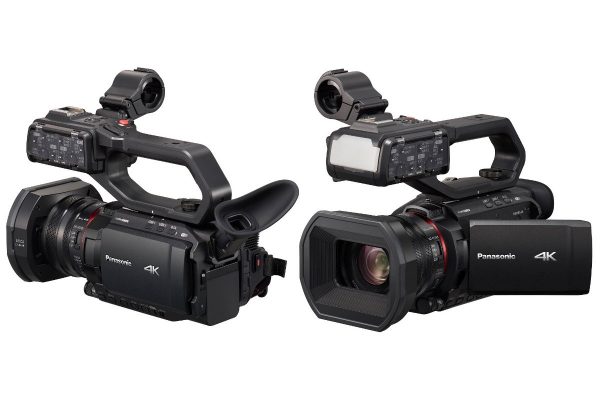Does the Canon XA20 have that perfect combination of portability, functionality and a small price tag?
Review: David Whitehead
If you are contemplating coughing up some serious money for a DSLR and the associated bits that make them play (almost) nice for video, stop right now, turn left, and before you do anything else, take a close look at the latest generation of digital video cameras – the cameras that were actually designed from the ground up to shoot video. A prime example of these – and one that’s aimed at the high-end enthusiast, although equally suitable for the run ’n’ gun news gathering brigade – is the new Canon XA20.
FEATURES & FUNCTIONS
There are certain facilities that a pro-level camera really must have to properly perform its duties. Some are obvious: a socket to plug in a set of headphones so that audio can be properly monitored; the option to plug in external mics such as a radio mic and a proper viewfinder, as well as an LCD, for example. And in these areas, the Canon XA20 does not disappoint. But many video cameras half the price of the XA20 also have these features so does anything else set it apart? Well yes, actually, lots.
To review the XA20, we didn’t simply rely on a ‘test bench’ methodology and test the specifications. The camera was used in a variety of environments to see how it responded, including bright sunlight, low light, high-speed shooting environments, and shooting landscapes and flora and fauna.
LENS & BITS
Canon lenses are legendary. Add to that the electronics and clever bits from Canon’s up-market pro range of video cameras, and you have a powerhouse of a baby camera.
The lens is a 2.8mm f/1.8-2.8 animal, with a 20x optical zoom. Of course, at this level, you expect genuine optical image stabilisation and that’s exactly what you get. As mentioned, the processing chip is straight out of the high-end Canons and is a single 1/2.84-inch HD CMOS chip utilising Canon’s proprietary DIGIC DV4 engine.
If you are more used to 35mm nomenclature, this makes the lens equivalent to a 28-576mm when the Dynamic IS (image stabilisation) is turned on. In other words, not too shabby.
The processor has a total count of a fraction under 3 megapixels.
The predecessor to the XA20, the XA10, was stunning in its low light capability and the XA20 follows that lead. In Auto mode it can shoot in light down to 1 lux, while if Slow Shutter mode is activated, then this goes down to 0.1 lux.
You also get very respectable focus distances with a minimum focus of 60mm throughout the normal zoom range, and down to 10mm when in Wide Angle mode.
Final information of interest to the techie types is an aperture range of f1.8-f8; there is a filter diameter of 58mm (if you like add-ons such as Cokin kits etc.) and there is a built in ND (neutral density) filter.
PHYSICAL BEAST
The Canon XA20 is much smaller than the behemoths that preceded it (barring the XA10). Indeed, it is not much larger than a basic consumer camcorder. Setting it apart physically are the top mounted handle, the external microphone mount and the audio panel containing controls and twin XLR inputs for microphones. (An advanced version of the XA20, the XA25, also has SDI or serial digital interface connectivity for genlocking to other cameras).
Zooming can be achieved a number of ways. For the professional purists there is a front-mounted ring, and for the more standard, a body-mounted rocker switch. Finally, for those that like touch screens, the 3.5-inch flip out LCD is touch screen compatible. Zoom is selectable as either high-speed or soft, and in the slow mode, there are 16 levels available.
The LCD panel contains a gold mine of information acting as a monitoring panel, with indicators for peaking, magnification focus assist, and zebra striping. Once you have found settings that suit a specific environment, these can be assigned to one of five custom buttons – each of which can contain 22 separate functions.
Standard controls include shutter and aperture priority, manual exposure, exposure compensation and automatic gain.
The Canon XA20 is 131mm x 180mm x 231mm when fully optioned with the detachable handle attached and a battery in place. Also in this mode, the weight is a fraction over 1kg. The supplied battery is said to give around 145 minutes of recording time but sadly, charging is only on board – there is no external charger supplied in the box.
FUNCTIONALITY
Unlike a consumer camcorder, the operating functionality of the XA20 is far and away beyond a simple point and shoot affair. Of course, you can put the XA20 into fully Auto mode and, in fact, if you are graduating to this camera from a basic unit, it’s a good idea to start this way and slowly explore and become familiar with the additional functionality.
If your experience is limited to a more auto-based camcorder, functions you may not be immediately familiar with include exposure metering, exposure compensation, auto gain, shutter speed and Program AE. Those who have an SLR or DSLR background will be familiar with these.
In the SmartAuto mode, there are presets for particular environments or modes including Portrait, Snow, Beach, Sunset, Night, Spotlight and Fireworks. There’s even an Infrared mode and infra red lamp. Other creative facilities available are a cinema-look filter with nine options, and image effects for brightness, contrast, sharpness and colour depth.
SHOOTING FOR THE FUTURE
An innovation that is being seen more and more in cameras and camcorders alike is wireless functionality that can serve a number of purposes. At its most basic, a smartphone or tablet (currently Apple iOS-only in the XA20) can be used as a remote control/monitoring system for the XA20. At the other end of the scale, data stored on SD cards in the XA20 can be sent via wi-fi to an FTP or media server (assuming access to an internet access point).
At this stage in testing, the built-in Canon protocols do not support external storage from the XA20 to such devices as Seagate wi-fi hard drives. No doubt this will come in future iterations.
In conjunction with wi-fi, the XA20 also has built in GPS functionality.
The potential market for the Canon XA20 is threefold. The first is the existing camcorder user wishing to update from a more basic consumer unit to one with more control and functionality, but without a huge price tag. The second is for the experienced DSLR shooter who has tried the video route with their DSLR and discovered the pitfalls that do exist by taking that tack. The third is the documentary maker or news gatherer who needs portability and to a degree, unobtrusiveness. In all these areas, the XA20 is a worthy option.





Cody Kitaura
Does anyone have experience with the XA and XF cameras? I like the idea of having actual buttons (XF) instead of a touchscreen (XA), but I like that the XA has a stronger zoom …
Nixygirl
Sadly, I’ve yet to have a play on either of these cameras. We’ll have to book one for review sometime.
– Nicole, V&F’s web editor.